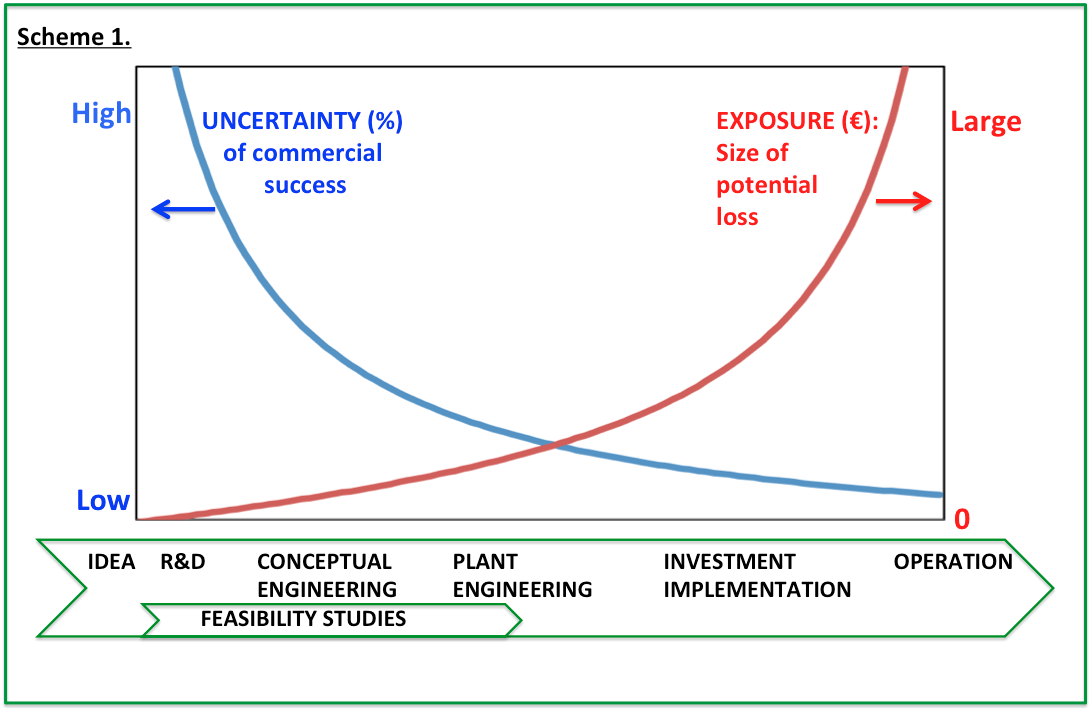As experienced project managers know so well, the key to bringing an industrial investment project successfully to its completion is that the level of uncertainty is brought to a low level before major capital expenditure. The more capital is invested in a project, the larger is the exposure to potential losses, e.g., in the case of delays or failures. This is illustrated in Scheme 1.
Of course, as managers of business operations know all too well, uncertainty in business is never quite at zero, and some risk is always present. Nevertheless, a smoothly operating industrial complex shall hold only a tiny fraction of the uncertainty that an early stage R&D project can happily host.

To be innovative, a company must manage development projects from their embryonic stage of high uncertainty to their commercial stage of high exposure. Normally, however, such companies don’t have all the necessary expertise and capabilities within it’s own organization, but they use the services of selected partners, instead.
Curiosity for ideas and tolerance of their initial uncertainty is important to innovation, but even more important is the ability of bringing this high initial uncertainty down fast, cost efficiently and in an organized manner. Inability of doing this is the usual cause of failed innovation projects. Quoting Rainer Häggblom, Chairman in Vision Hunters Ltd., formed Chairman and CEO of Jaakko Pöyry Consulting Ltd. and a good friend of mine, “Innovation without commercialization is mere hallucination.”
SciTech-Service has a long history of serving its customers in bringing down uncertainty at all stages of innovation and investment projects (shown along the x-axis of Scheme 1.) Providing ideas, R&D services and conceptual engineering is where we have developed unique skills and capabilities in our home field: Pulping and board/paper making, biorefinery processes, and viscose and other regenerated cellulosic fibers.
The inability of bringing down high initial uncertainty also makes companies turn away from novel ideas altogether, which, in the long run, puts competitiveness and survival at risk. This sometimes happens even in successful companies with abundant resources and in a good position to innovate. To me, this suggests that the discipline of innovation management is not at the same high level as other management in these companies.
As a reference, the management of investment projects is often the most disciplined branch of the entire management in manufacturing companies. This is understandable, as a high amount of capital is spent on mill investments in such companies. However, for the management and utilization of a company’s intellectual capital, innovation is a core capability.
CONCEPTUAL ENGINEERING
The “Conceptual engineering study”, a key product in SciTech’s range of services, is the necessary bridge between R&D and an investment project. It can provide our customers with the readiness for enquiring quotations from plant engineering companies and equipment suppliers, also when novel technologies are involved.
Our conceptual engineering study is specifically designed for bringing down the uncertainty before entering the more capital intensives stages of an investment project – be it more or less innovative by its origin.
A more detailed discussion of what conceptual engineering is about is certainly worth of another blog text – that will follow. Or, you can always contact us directly!